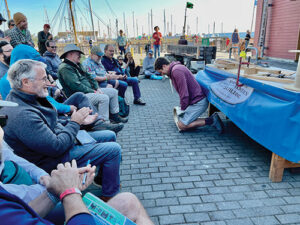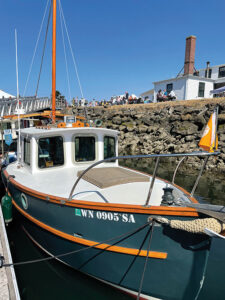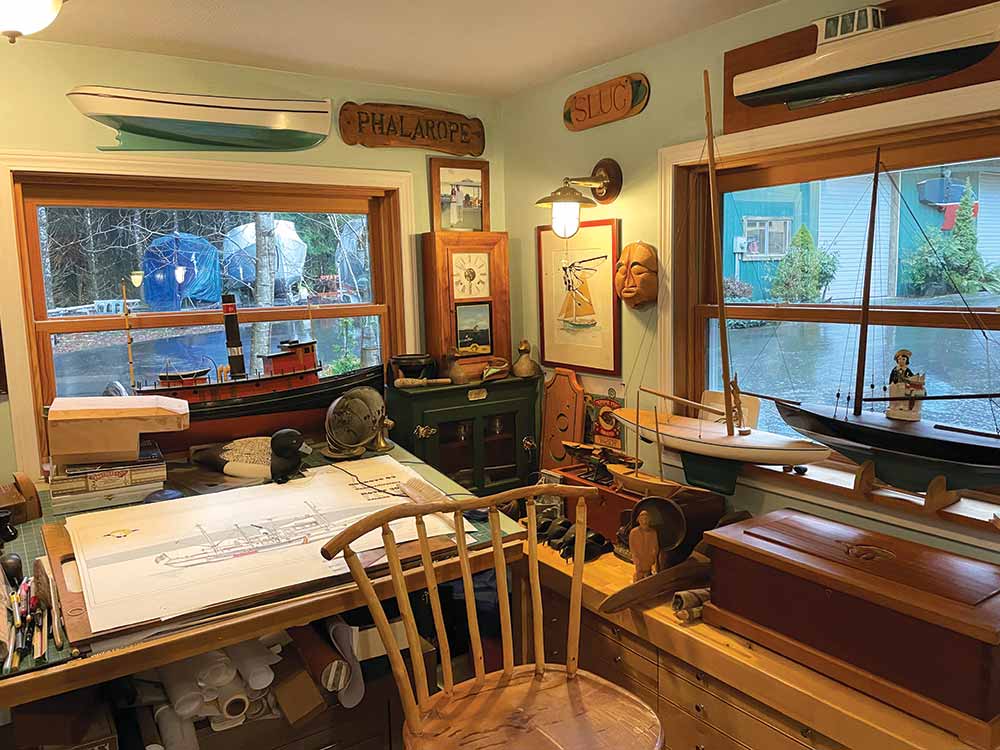
The boat manufacturing industry, like the car and aviation industries, has its share of variety, allowing the buyer to select just about anything that he or she could imagine, and promising that a boater can and should “fall in love” with their boat.
When we bought Ariel two years ago, we felt that the 1973 Columbia 28 was right for us. Although I must cautiously confess that I wouldn’t describe my feelings for her using the word “love.” She was perfect for our needs as new sailors, but now my wife Laura and I find that she is not the best cold weather boat for fair weather sailors like ourselves.
 After purchasing the old sloop, we foolishly expected to sail her year-round, blissfully ignorant of how harsh our adjustment to Pacific Northwest winters and springs would be. It only took one or two outings to understand why so few boats leave the harbor in these months and why some of our dock mates winterized their boats with deck and hatch covers. Also, it gave us a healthy respect and admiration for the sailors who are hardy enough to venture out in inclement weather.
After purchasing the old sloop, we foolishly expected to sail her year-round, blissfully ignorant of how harsh our adjustment to Pacific Northwest winters and springs would be. It only took one or two outings to understand why so few boats leave the harbor in these months and why some of our dock mates winterized their boats with deck and hatch covers. Also, it gave us a healthy respect and admiration for the sailors who are hardy enough to venture out in inclement weather.
Spending any time at all on Ariel required heavy coats and heaters fueled by whatever source worked: electricity, propane, or kerosene. The ‘Little Buddy’ propane heater that we bought really earned its name that first winter. Our sailing friends were in two camps: the aforementioned group who chose to close up their vessels for the winter, and the “stout of mind and body” group who managed to find enjoyment in spite of the chill and who encouraged us to buy better foul weather gear.
We haven’t quite gotten used to the idea that in the PNW, if you’re waiting for dry weather to attend an event or complete a task, you might as well scratch it off your list. Bundling up against the cold still didn’t seem like the solution — even with the coming of slightly warmer weather in the spring, our sailing days were limited by rain. Foul weather gear might keep our skin dry and our bodies warmer, but it doesn’t do much for our dampened spirits.
We’ve considered purchasing a dodger for Ariel, but frugality tells us that we shouldn’t spend more on accessories for the boat than its original price. I’ve toyed with the idea of building a DIY dodger, but my initial research shows that the cost of quality materials is still excessive, and a jury-rigged contraption of my design is sure to fail under heavy winds and seas. I could proto-type the structure, but I’m right back to cost, labor, and time.
It’s difficult to admit that maybe Ariel is not the Goldilocks boat for me and Laura after all. And no, it’s not one-foot-itis. Her size, for a sailboat, really is perfect for us. But what if we are committed to not sailing from December through March? We have a large enough driveway to store her for those months, so we could trail her to our house. The immediate, although not insurmountable challenge is to find a trailer for her and deal with mast removal. Again, we’re running against value and expense.
We could sell her and maybe buy a small powerboat with an enclosed cabin for the winter months and utilize the Cal 20 sailboats that our club offers for use in the summer. The powerboat could be stored at our home and then trailered to a marina, saving on monthly moorage fees. But we’d be giving up on sailing our own boat if we chose the Cal 20s.
In a perfect world, could we find a boat that satisfies all of our conditions? Warmth, comfort, sails, and affordability? We are now on the lookout, whether it be an internet search, a trip to a reciprocal yacht club’s marina, flipping open an issue of 48° North, or a visit to an annual expo or festival, like for example, The Wooden Boat Festival.
When we attended the annual festival for the first time last fall, we were a bit skeptical. No matter how romantic wooden boats may be, we heard that maintaining one can be all-consuming. But after a day in the sun in the idyllic setting of Port Townsend, the festival shifted our thinking a bit, with highlights of how-to workshops for me and beautiful small boats for Laura. The arrays of vessels in the marina and in the boat shop ranged from cute and artistic to beautiful and magnificent. But what we honed in on might just be the next boat for us.
After having seen one of designer Sam Devlin’s small boats in the Salish 100, we became aware of the practicality of a small vessel with a pilothouse. The real key for us is to be able to steer the boat from inside a warm, covered cabin during winter, enjoy an aft deck with seating for four in pleasant weather and, if possible, sail a little.
When a friend suggested that I check out Devlin’s website, I was amazed by the abundance of designs, for which many have either plans or pre-cut kits available. I envied nearly every design, some for practicality, others to either challenge or sharpen my building skills, and others because they seemed to possess those features that Laura and I want in a boat. Like a kid in a candy store (or a carpenter in a tool shop) I perused the website for dreamboats and reality boats alike.
For example, Devlin’s Camarone 34 or 40 look like ideal motor-sailers, but their size intimidates new sailors like Laura and me. (That and the price tag or the years that it would take me to build either one!) Looking through Devlin’s incredible work, I wondered if a thorough exploration of his array of designs might be impossible, as it seems that he adds new ones constantly.
As we strolled the Point Hudson Marina during the festival, eyeing everything from kayaks to cat boats to cruisers, we came upon Sam Devlin himself, sitting in one of his latest creations, a tug-like powerboat that looked rock solid and roomy. It was difficult not prostrating ourselves right there on the pier in front of the famous designer. But his down-to-Earth nature and rejection of our accolades put us at ease instantly.

When we briefly described our requirements for our perfect boat, he directed us to one of his models, moored just across from his perch on the foredeck of his TugZilla 26. We turned around, stared, looked at each other, and said in unison, “That looks like the boat that we saw in the Salish 100!” But unlike getting only a dockside view at that previous event, we were able to board Whistler, a Surf Scoter 22, given the permission of its owners, Randy and Karen Cox.
Randy was generous in his knowledge and hospitality, offering the history of, and design process for, Whistler. Laura and I were entranced with the spaciousness of the V-berth, the comfort of the pilothouse, and the layout of the cockpit.

Our only disappointment was the lack of sail power, with the small aft mizzen sail used only for stability, not power. As Randy had worked with Devlin, he was able to recommend another design, a small motor-sailer, the Lit’l Coot, which I promptly viewed upon returning home.
I became so intrigued with Devlin’s designs that I made an appointment to visit him at his current construction facility north of Olympia. We met him there on a cold and wet January day, amidst evergreens, man-made ponds, and storage barns, through which he graciously toured Laura and I, with his German Shepard, Oso, occasionally at his side. In the warmth of his workshop, which currently houses one of his models from 1996 with a beautiful new paint job, Devlin gave us a little history of his company and philosophy of his design process.
He started his successful career path with a simple sketch of a small boat for a friend while working in the fishing industry in Alaska. Even though he doubted that he could make a living designing and building boats, he finds himself 40 years later, still sketching boat hulls, pilothouses, and rigging, although now he relies primarily on computer-aided design (CAD) programs to bring his ideas to life.
CAD allows Devlin to make minor changes to a drawing with a click of the mouse. Prior to using a computer, an alteration to the sketch would have required him to completely erase a portion of the drawing and redraw the edited section. Designing on a computer also allows him the ability to send the images directly to a CNC machine, which laser cuts the parts with amazing accuracy, enabling Devlin to offer pre-cut kits to do-it-yourselfers like me.
But Devlin himself essentially builds only one wooden-hulled boat at a time, although on rare occasions he has “assembly-lined” maybe five or six small dinghies. This unique approach to manufacturing allows him to continually adjust and improve his designs. He believes that mass-producing using molds for fiberglass hulls freezes innovation. And Devlin is constantly evolving, generating new methods and designs.
When Laura and I asked Devlin about his Surf Scoter and Li’l Coot models, he quickly informed us that he had improved both, increasing the sizes of each by a couple of feet, adding an enclosed head, and adjusting the hull shape for increased speed beyond the formula-calculated maximum.

The final specs for the boats are not yet published, but in researching the original model we found that the version one of the Lit’l Coot is just under 18 feet in length with a 7-foot beam and a 2-and-a-half-foot draft. Her twin masts make her a yawl, utilizing a tabernacle hinged mainmast, which makes stepping the main an unthreatening prospect. So the boat is trailable, sailable, and powerable! She can use the same Yamaha 9.9 as Ariel, an engine which, after having its carb cleaned and fuel filter/water separator serviced, performs comfortably and fuel-efficiently.
While the Devlin boat seems to fit the bill for us, at least for now, we will continue our search, exploring other options that may yet appear to us. Our search has presented us with the Crealock 40 pilothouse as an option, although its size and price tag may remove it from serious consideration. And the Cooper 353 Pilothouse, Nauticat, Morgan, Cheoy Lee, and custom are all possibilities for future “perfect” boats.
When I was a kid, aviation, not sailing, was a big part of my family’s life. My dad loved planes the way we’re coming to love boats. It never ceased to amaze me that after he spotted an aircraft making its way across the afternoon sky he could identify the type of plane without binoculars. Maybe my dad was able to name every plane in the sky because there were simply fewer makes and models back then, as was also the case for cars and boats. Mass production has given the public so many more options to choose from. But, as Devlin laments, many of those models don’t have what he calls “the whimsy factor.”
What makes any vessel desirable, whether it be one for the air, land, or sea, Devlin believes, and I whole-heartedly agree, is the whimsy factor. For some, that may be luxury, for others, convenience and practicality; still others might find it in uniqueness or originality.
Until Laura and I discover what the whimsy factor looks like to us, we’ll just bundle up for the winter months, and get comfy and cozy with Ariel until the spring thaw brings us sunshine, warm days, and mild breezes. From smitten to frostbitten, in dreams and real experiences on the water, it’s all part of our journey into the wondrous world of boats and the Salish Sea.
David Casey is a retired math teacher and semi-professional woodworker and bass player. He plans on using his retirement to build a small sailboat and a kayak, and to explore the waters of southern Puget Sound.






